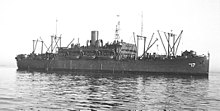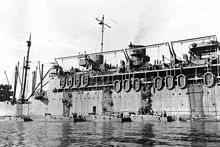



Attack transport is a United States Navy ship classification for a variant of ocean-going troopship adapted to transporting invasion forces ashore. Unlike standard troopships – often drafted from the merchant fleet – that rely on either a quay or tenders, attack transports carry their own fleet of landing craft, such as the landing craft, vehicle, personnel (LCVP) or Higgins boat.
They are not to be confused with landing ships, which beach themselves to bring their troops directly ashore, or their general British equivalent, the landing ship, infantry.
A total of 388 APA (troop) and AKA (cargo) attack transports were built for service in World War II in at least fifteen classes. Depending on class they were armed with one or two 5-inch guns and a variety of 40 mm and 20 mm anti-aircraft weapons.
By the late 1960s, 41 of these ships were redesignated with the hull symbol (LPA) landing platform, amphibious, but they all retained their names and hull numbers.[1][2][3][4]
- ^ World War II troopships - Army Center of Military History
- ^ Friedman, Norman (2002). U.S. Amphibious Ships and Craft. Naval Institute Press. p. 190. ISBN 978-1-55750-250-6. Retrieved 2009-07-13.
- ^ Origins Marines.mil, Of The Gator Navy
- ^ hyperwar, APD -- High Speed Transports, and LPR -- Amphibious Transports, Small.
© MMXXIII Rich X Search. We shall prevail. All rights reserved. Rich X Search
